Research and Planning
Converting an automatic to a manual transmission requires thorough research and planning․ Start by assessing your vehicle’s compatibility and understanding the mechanical requirements․ Gather information on necessary parts, such as the transmission, clutch, and shifter․ Plan modifications to the chassis, wiring, and ECU․ Evaluate costs and time, ensuring you have the tools and expertise․ Professional guidance is often essential for a successful swap․
Proper planning ensures a smooth and safe conversion process․

Transmission Swap
Swapping an automatic transmission for a manual involves removing the existing automatic unit and installing a compatible manual transmission․ This process requires precise mechanical skills and specialized tools․ First, disconnect the battery and drain the transmission fluid․ Remove the automatic transmission by detaching it from the engine and torque converter․ Inspect and prepare the bellhousing for the manual transmission, ensuring proper alignment and fitment․ Install the manual transmission, securing it firmly to the engine․ Reconnect the driveshaft and ensure proper drivetrain alignment․ Key components like the clutch kit, flywheel, and pressure plate must be installed to complete the mechanical conversion․ Additionally, the shifter and its linkage need to be mounted correctly to ensure smooth gear changes․
Some vehicles may require modifications to the transmission tunnel or floorpan to accommodate the manual transmission․ It is crucial to verify that all bolts and connectors are securely fastened to avoid leaks or mechanical failure․ The complexity of this step often necessitates professional assistance, especially for novice enthusiasts․ Proper alignment and secure installation are critical to ensure optimal performance and longevity of the new manual transmission․ This step is foundational to the success of the entire conversion process․
A successful transmission swap sets the stage for the remaining steps in the manual conversion․
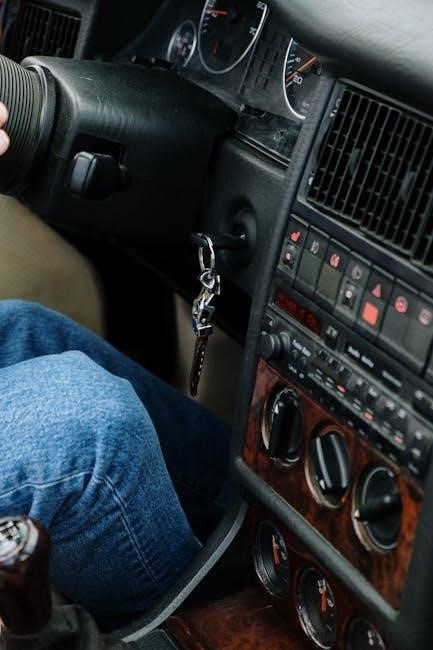
Clutch Pedal Installation
Installing a clutch pedal is a critical step in converting an automatic transmission to manual․ Begin by removing the driver’s seat to access the pedal area․ Locate the existing brake pedal assembly and identify the space where the clutch pedal will be mounted․ Drill holes in the firewall or pedal bracket to accommodate the new pedal assembly, ensuring proper alignment and clearance․ Secure the clutch pedal to the firewall or frame using bolts, making sure it operates smoothly without binding․ Connect the clutch master cylinder to the pedal, ensuring the rod is properly aligned and adjusted for optimal pedal feel․
Next, install the clutch master cylinder on the firewall, connecting it to the clutch pedal via the rod․ Bleed the hydraulic system to remove any air bubbles, ensuring the clutch engages and disengages smoothly․ Mount the clutch slave cylinder on the transmission and connect it to the master cylinder using hydraulic lines․ Adjust the pedal free play and ensure the clutch engages fully when the pedal is pressed․ For vehicles with electronic interfaces, additional wiring may be required to integrate the clutch switch with the vehicle’s systems․ It is essential to test the clutch operation multiple times to ensure proper function and safety before proceeding with other components․
Professional assistance is highly recommended if you are unfamiliar with hydraulic systems or pedal assemblies․ Proper installation ensures smooth and reliable operation of the manual transmission, making this step vital for the overall success of the conversion․ A well-installed clutch pedal system enhances driver control and performance․
A properly installed clutch pedal is essential for precise control over the manual transmission․
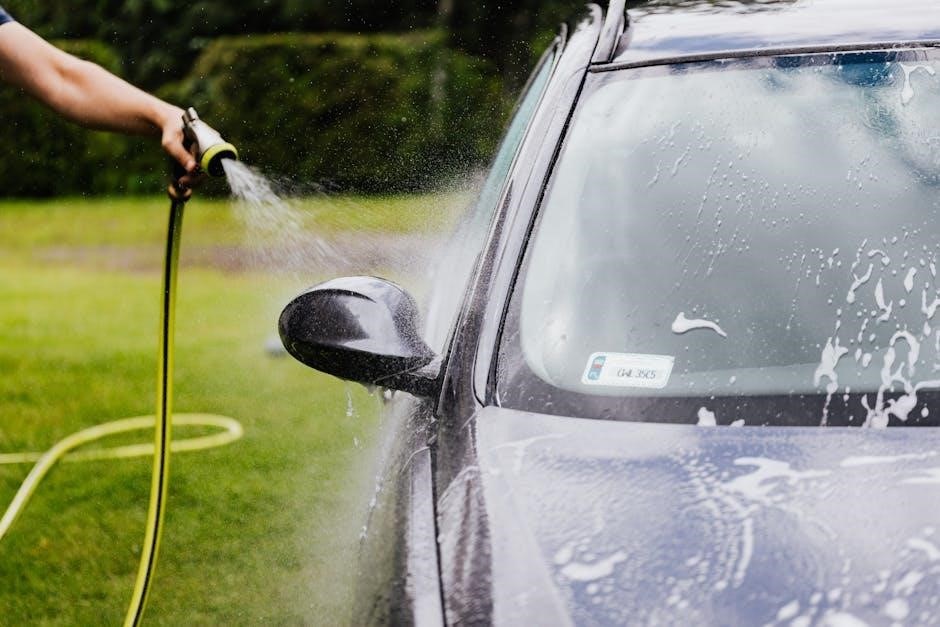
Gear Shifter Replacement
Replacing the gear shifter is a key step in converting from an automatic to a manual transmission․ Start by removing the automatic shifter assembly, including the center console and any associated trim pieces․ This will provide access to the transmission tunnel, where the new manual shifter will be installed․ Inspect the transmission tunnel for any obstructions or modifications needed to accommodate the manual shifter’s linkage․
Mount the manual gear shifter to the transmission tunnel, ensuring proper alignment with the transmission’s gear lever․ Secure the shifter using bolts or brackets, depending on the vehicle’s design․ Connect the shifter linkage to the transmission, adjusting the length and alignment to ensure smooth gear shifts․ For vehicles with floor-mounted shifters, fabricate or install a shifter mounting plate if the original automatic shifter mounts are incompatible․
Test the shifter by cycling through all gears, ensuring each gear engages cleanly without resistance․ Adjust the shifter linkage as needed to achieve proper gear alignment․ Replace the center console and trim pieces, modifying them if necessary to fit around the new manual shifter․ For vehicles with electronic interfaces, integrate the reverse light switch and any other necessary sensors into the shifter assembly․
If the original shifter hole in the floor is too small or misaligned, fabricate a new opening or use an adapter plate to fit the manual shifter․ Ensure the shifter is securely fastened and operates smoothly before finalizing the installation․ A well-installed gear shifter is essential for precise control over the manual transmission, enhancing the driving experience․
A properly fitted gear shifter ensures smooth and precise gear changes, making it a cornerstone of the manual conversion process;

Electrical and ECU Adjustments
Converting from an automatic to a manual transmission requires significant electrical and ECU adjustments to ensure proper operation․ The automatic transmission relies on electronic controls to manage gear shifts, which must be reconfigured for manual operation․ Start by reprogramming the Engine Control Unit (ECU) to remove automatic transmission controls and integrate manual transmission logic․ This step often requires custom ECU coding or aftermarket solutions to disable features like torque converter engagement and automatic shift protocols․
Modify the wiring harness to connect the manual transmission components, such as the clutch pedal switch and gear position sensor․ The clutch pedal switch signals the ECU when the clutch is pressed, allowing for smooth engine control during shifts․ Install a reverse light switch on the manual transmission to activate the backup lights when the car is in reverse gear․ Additionally, integrate the gear shifter’s position sensor to provide real-time feedback to the ECU․
In vehicles with advanced driver assistance systems, recalibrate the electronics to recognize the manual transmission inputs․ This may involve updating the vehicle’s software or installing aftermarket modules designed for manual conversions․ Ensure all electrical connections are secure and routed properly to avoid interference or damage․ For vehicles with automatic-to-manual conversion kits, follow the manufacturer’s instructions for wiring and ECU adjustments․
Test the electrical system thoroughly after installation, verifying that all components communicate correctly with the ECU․ Address any error codes or irregularities promptly to prevent drivability issues․ Proper electrical and ECU adjustments are critical for seamless operation of the manual transmission, ensuring optimal performance and driver control․
Accurate electrical and ECU configurations are vital for a successful manual transmission conversion, enabling smooth and responsive gear changes․
Cooling System Evaluation
Evaluating the cooling system is a critical step when converting from an automatic to a manual transmission․ Automatic transmissions often rely on dedicated coolers integrated into the radiator or as standalone units to manage heat generated by the torque converter․ When switching to a manual transmission, these components may no longer be necessary, but the cooling system still requires attention to ensure optimal performance․
Inspect the transmission cooler lines and connections to determine if they can be repurposed or if new lines are needed for the manual transmission․ In some cases, the manual transmission may generate less heat than its automatic counterpart, but high-performance driving or heavy loads can still stress the system․ Consider upgrading the radiator or adding an auxiliary cooler if the vehicle will be subjected to extreme conditions․
Check the condition of the existing cooling system, including the radiator, hoses, and coolant․ Ensure there are no leaks or blockages that could compromise cooling efficiency․ For vehicles with high-performance manual transmissions, additional cooling measures, such as a transmission oil cooler, may be necessary to prevent overheating during aggressive driving or towing․
Verify compatibility between the manual transmission and the vehicle’s cooling system․ Some manual transmissions may require specific cooling ports or adapters, which should be addressed during the conversion․ Test the system under various driving conditions to ensure it maintains proper temperatures and functions reliably․
A thorough cooling system evaluation ensures the manual transmission operates efficiently and reliably, even under demanding conditions․

Driveshaft Inspection
Inspecting the driveshaft is a crucial step when converting from an automatic to a manual transmission․ The driveshaft plays a vital role in transferring power from the engine to the wheels, and its condition and compatibility must be verified to ensure smooth operation with the new manual transmission․ Begin by removing the driveshaft and inspecting it for any signs of wear, damage, or misalignment․ Check the universal joints for play or damage, as these components are prone to wear over time․ If any parts are damaged or excessively worn, they must be replaced to prevent vibration or failure during operation․
Next, ensure the driveshaft is compatible with the manual transmission․ Automatic and manual transmissions often have different driveshaft lengths, splines, and yokes․ Measure the driveshaft to confirm it matches the specifications required by the manual transmission․ If modifications are needed, such as shortening or lengthening the driveshaft, consult a professional to ensure precision․ Proper alignment is critical to avoid excessive noise, vibration, and premature wear on drivetrain components․
After verifying compatibility, inspect the driveshaft’s balance and integrity․ An imbalanced driveshaft can cause vibrations, especially at higher speeds․ If necessary, have the driveshaft rebalanced or replaced․ Additionally, check the driveshaft’s protective components, such as the center bearing and heat shields, for any damage or wear․ Replace any damaged parts to maintain proper functionality․
Finally, test the driveshaft after installation to ensure it operates smoothly with the manual transmission․ Listen for unusual noises, such as clunking or whining, and monitor for vibrations․ If any issues arise, address them promptly to prevent further damage to the drivetrain․
A thorough driveshaft inspection and necessary modifications ensure compatibility and optimal performance with the manual transmission․
Cost and Time Considerations
Converting an automatic transmission to a manual transmission involves significant financial and time investments․ The total cost varies widely depending on the vehicle’s make, model, and the specific components required․ Expect to spend between $1,000 and $3,000 or more, including the manual transmission, clutch, flywheel, shifter, and other necessary parts․ Labor costs can add another $500 to $2,000, depending on the complexity and the mechanic’s expertise․ If custom modifications or rare parts are needed, the price can escalate further․
Time is another critical factor․ A skilled mechanic may complete the swap in a few days, but for a DIY enthusiast, it could take several weeks, especially if unfamiliar with the process․ The duration depends on the availability of parts, the vehicle’s complexity, and the individual’s mechanical aptitude․ Additionally, unexpected issues, such as wiring harness modifications or drivetrain compatibility problems, can extend the timeline․
Plan for potential delays and additional expenses․ Researching suppliers and comparing prices can help minimize costs, but prioritizing quality is essential․ Budget extra for tools, fluids, and any unforeseen repairs․ Consulting with a professional mechanic or transmission specialist can provide a more accurate estimate tailored to your vehicle and situation․
Understanding the costs and time required helps prepare for a successful transmission conversion․
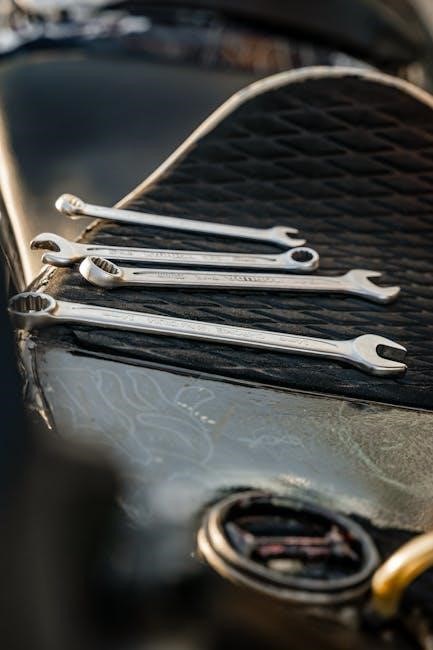
Legal and Licensing
When converting an automatic transmission to a manual, it’s crucial to consider legal and licensing implications․ In many regions, vehicles with manual transmissions require a specific driver’s license endorsement․ If your license is currently restricted to automatic transmissions, you may need to update it to operate a manual vehicle legally․ Check with your local Department of Motor Vehicles (DMV) or equivalent authority to understand the requirements․
Additionally, the conversion must comply with local vehicle regulations․ Notify your DMV or transportation agency about the modification, as the vehicle’s registration and title may need updating․ Some jurisdictions require inspections to ensure the conversion meets safety and emissions standards․ Failure to comply could result in fines or legal consequences․
Insurance is another consideration․ Inform your insurance provider about the transmission swap, as it may affect your policy․ Some insurers offer discounts for manual transmissions, while others may require adjustments to your coverage․ Ensure your policy reflects the modified vehicle to avoid issues in case of a claim․
Finally, be aware of any regional laws regarding vehicle modifications․ Some areas have strict rules about altering a vehicle’s original specifications, including the transmission․ Research local ordinances to ensure your conversion is legal and avoid potential penalties․
Always verify legal requirements to avoid penalties and ensure safe, lawful operation of your manual transmission vehicle․
Maintenance and Driving Skills
Maintaining a manual transmission and developing the necessary driving skills are critical after converting from an automatic․ Regular maintenance ensures the longevity of the transmission and clutch system․ Check the clutch fluid levels periodically and replace the clutch when wear is evident․ Inspect the gear oil and top it off as needed to prevent overheating and wear on moving parts․ Adjust the clutch pedal free play to maintain proper engagement and disengagement․
Mastering manual driving skills takes practice․ Start in a safe, open area to learn clutch control and smooth shifting․ Avoid “riding the clutch,” as this can cause premature wear․ Practice accelerating gradually, using the clutch and gas pedals in harmony․ Shift gears smoothly, especially when downshifting before stopping, to avoid jerky movements․ Familiarize yourself with the gearshift’s resistance and the clutch’s engagement point for seamless transitions․
Driving in heavy traffic or hilly terrain requires additional finesse․ Use the correct gear for the situation to maintain control and prevent overheating the clutch․ On steep inclines, downshift to a lower gear to maintain speed and traction․ In stop-and-go traffic, use the clutch and brake carefully to avoid overheating the clutch and wearing it out prematurely․
Regularly inspect the clutch cable or hydraulic system for leaks or wear․ Replace worn clutch components promptly to avoid costly repairs․ Keep the transmission mounts secure to prevent misalignment and vibration․ By staying proactive with maintenance and refining your driving techniques, you can enjoy the benefits of a manual transmission while extending its lifespan․
Proper maintenance and skilled driving are essential to maximize the performance and durability of your manual transmission․
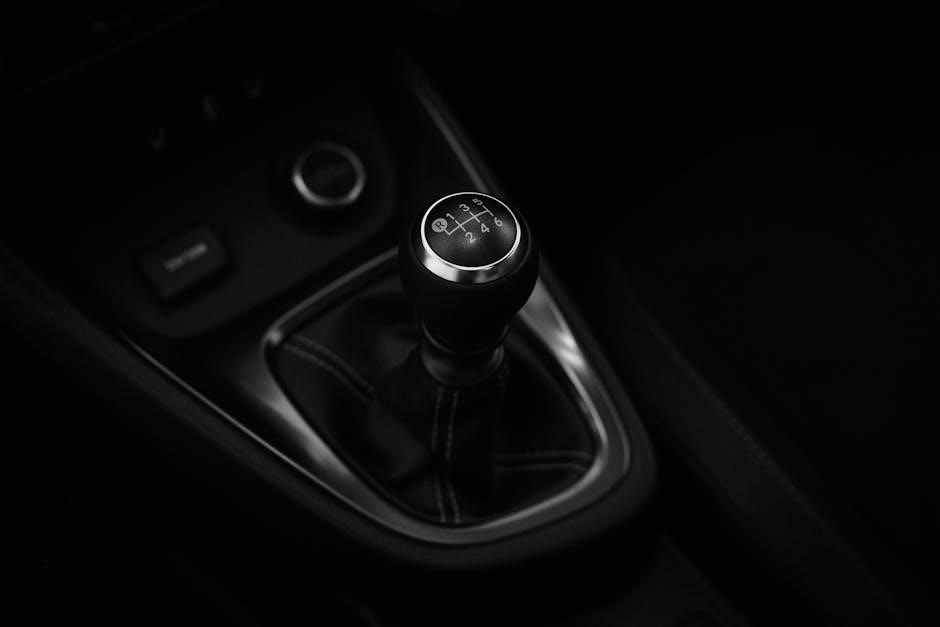
Workspace and Tools
Preparing a suitable workspace and gathering the necessary tools are crucial for a successful automatic-to-manual transmission conversion․ Choose a well-ventilated, flat workspace with enough room to access the vehicle from all sides․ Ensure the area is clean and free from flammable materials, as welding or electrical work may be involved․
A basic toolkit should include wrenches, screwdrivers, pliers, and punches․ Specialized tools like a clutch alignment tool, transmission jack, and torque wrench are essential for specific tasks․ If modifications to the chassis or drivetrain are required, consider investing in a welder and metalworking tools․ A hoist or lift can make the process safer and more efficient, allowing better access to the transmission and surrounding components․
Organize your tools and parts in a logical manner to streamline the workflow․ Label each component as it is removed to avoid confusion during reassembly․ Keep a comprehensive set of repair manuals or online guides nearby for reference․ If you lack experience, consider enlisting the help of a skilled mechanic or joining a DIY community for support․
Adequate lighting and a comfortable workspace can significantly reduce fatigue and improve precision․ Use protective gear, such as gloves and safety glasses, to safeguard against injuries․ Plan for contingencies, such as unexpected repairs or part delays, by maintaining a flexible schedule and budget․ A well-prepared workspace and the right tools will help ensure the conversion process is efficient and trouble-free․
A properly equipped workspace and the correct tools are indispensable for a successful transmission conversion․
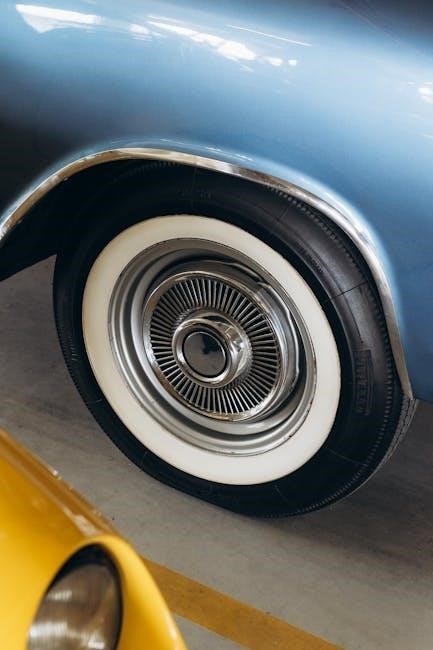
Evaluation of Benefits
Converting an automatic transmission to a manual offers several advantages that can enhance your driving experience and satisfaction․ One of the most significant benefits is the increased control over the vehicle, allowing for more precise acceleration and deceleration․ This can improve overall performance, especially in situations requiring quick shifting, such as spirited driving or navigating hilly terrain․
Another key benefit is the potential cost savings․ Manual transmissions are generally more fuel-efficient than their automatic counterparts, particularly in city driving or heavy traffic conditions․ Over time, this can lead to noticeable reductions in fuel expenses․ Additionally, manual transmissions tend to require less maintenance and are often more durable, reducing long-term repair costs․
For enthusiasts, the tactile experience of driving a manual transmission is unparalleled․ The engagement of operating a clutch and gear shifter creates a more direct connection between the driver and the vehicle, making the driving experience more enjoyable and immersive․ This is particularly appealing for those who value the art of driving and seek a more authentic connection to their car․
Furthermore, converting to a manual transmission can increase the resale value of your vehicle, especially for sports or classic cars where a manual gearbox is often preferred․ It also opens up the possibility of installing high-performance manual transmissions, such as a 6-speed unit, to further enhance the vehicle’s capabilities․
The rewards of a manual transmission far outweigh the challenges of the conversion process․

Implementation and Testing
Once the planning and preparation are complete, the implementation phase involves physically installing the manual transmission components․ Start by removing the automatic transmission, followed by the torque converter, and then install the manual transmission․ Ensure all mounting points are secure and aligned properly․ Next, focus on the clutch pedal installation, ensuring it is correctly positioned and connected to the clutch master cylinder․ The gear shifter should also be installed, with precise alignment to avoid any shifting issues․
After the mechanical components are in place, connect the electrical systems, including the clutch switch and any necessary wiring harnesses․ The ECU may need reprogramming to recognize the manual transmission setup․ Once everything is installed, perform a series of tests to ensure functionality․ Start with a stationary test, checking the clutch pedal feel and gear shifter operation․ Then, take the vehicle for a controlled drive to test acceleration, shifting smoothness, and overall performance․
During testing, pay close attention to any unusual noises, vibrations, or difficulties in shifting gears․ Address any issues promptly, as they may indicate improper installation or component incompatibility․ Fine-tune the clutch and shifter adjustments as needed to achieve optimal performance․ Finally, once everything functions correctly, the conversion is complete, and the vehicle is ready for normal use․
Thorough testing ensures the conversion is safe and reliable, providing a seamless driving experience․
